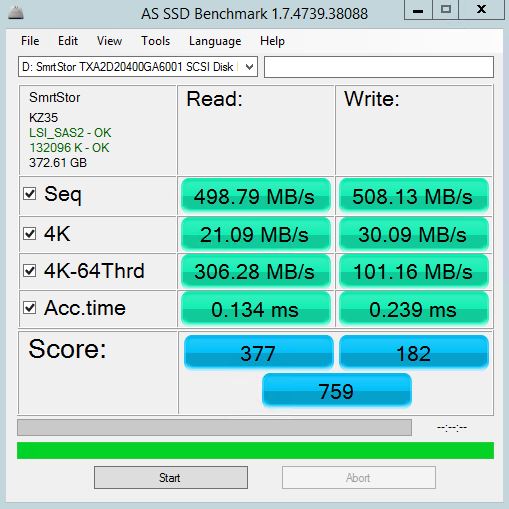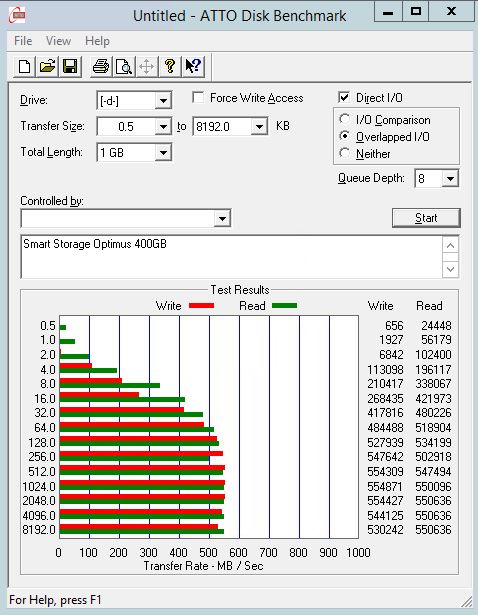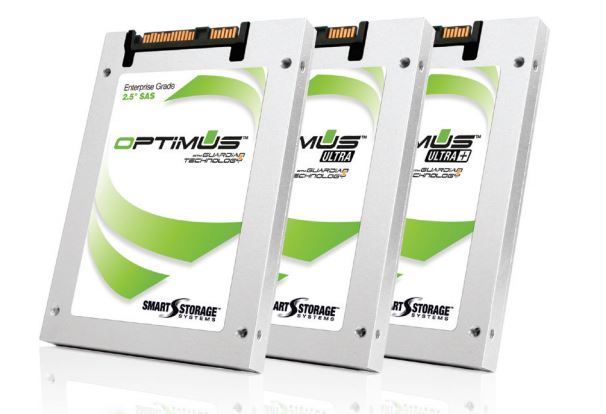Continuing our series with yet another SAS SSD, today we are running the SanDisk acquired SMART Storage Systems Optimus 400GB SAS SSD through some quick benchmarks. Like all of these enterprise SAS SSDs, the Optimus 400GB SAS SSD is intended to be run in heavier 24×7 workloads which are not approximated by these benchmarks. Those will follow along with some RAID 0 benchmarks. As we have found through testing, some enterprise SSDs seem to be optimized for >1 disk configurations.
SanDisk announced its acquisition of SMART Storage Systems in Q3 2013. It has since added the Optimus SAS SSDs along with other variants (e.g. the Optimus Eco) to its product catalog. The SanDisk Optimus MLC design incorporates 512GB of 24nm Toshiba Toggle NAND. The drive is then overprovisioned so that only 400GB is available and there is 112GB ready for wear leveling and other features of the Optimus’ controller. That is how the Optimus is rated to take 10 random full disk writes per day for its lifecycle. Further there are features such as a capacitor array for keeping the onboard Micron DRAM online long enough to dump contents in the event of a power failure. SMART also had a technology called FRAME which was essentially parity at a NAND level so that if a NAND package failed, the drive could continue operating.
The bottom line is that while the Pliant Lightning SLC drives were known to be extremely resilient drives, the Optimus SAS SSD takes a mix of consumer performance and enterprise reliability related features and yields a consistently speedy SAS drive.
For reference, we have already published quick benchmark results of the Pliant SanDisk Lightning 206s 200GB SLC SAS SSD and the Seagate Pulsar.2 200GB MLC SAS SSD. There is a lot more to come and we will also look at the drives in RAID 0 configurations just to see if that changes the performance picture. Again, like the other SAS SSDs we managed to purchase these drives for $0.55 – $0.60/ GB which is in-line with lower end consumer SATA SSD pricing. Our review samples were in good shape and had about four of their five year warranties remaining.
Test Configuration
Again, we are using our standard configuration for these tests using of already released hardware:
- Motherboard: Gigabyte GA-7PESH3
- Processors: Dual Intel Xeon E5-2690 (V2)
- SAS Controller: (onboard LSI SAS2008 in IR mode)
- RAM: 64GB DDR3L-1600MHz ECC RDIMMs
- OS SSD: Kingston V300 240GB
The LSI controller found onboard is the same as can be found in countless platforms and cards such as the IBM ServeRAID M1015 and LSI 9211-8i. We decided to use this controller since it is an extremely popular first-generation 6gbps SAS II controller. For those looking to build value SAS SSD enabled arrays, the LSI SAS2008 is likely going to be the go-to controller. A major point here is that we are using a SAS controller. This means that one cannot compare results directly to consumer-driven setups where a SATA SSD is connected to an Intel PCH port. There is a latency penalty for going over the PCIe bus to a controller to SAS. It also is a reason NVMe is going to be a game changer in the enterprise storage space.
One note on the SAS drives: SAS does operate at a higher voltage than SATA. That allows for better signal integrity and over longer cable lengths. In theory, the SAS drives are much better in remote disk shelves than their SATA counterparts. On the other hand, with lots of older-process NAND, a SAS interface and absolutely no intention of ever being used in a notebook, these drives use much more power than typical consumer SATA SSDs.
The SanDisk Optimus 400GB is rated at 7w so it does consume more power than modern consumer SATA SSDs.
SanDisk Optimus 400GB SAS Quick Benchmarks
It is important, especially with SSDs not to take a single test result at face value. One should look at a few different tests to get an idea of how the drives perform in different scenarios. To this end, AS SSD benchmark, CrystalDiskMark, ATTO all show different facets of performance. These are the simple/ quick benchmarks. In the near future we will do some comparisons with longer term write comparisons and latency testing that are closer to enterprise workloads. We are using a few of our standard tests to do a quick comparison to some of the other drives that have passed through the lab recently.
AS SSD Benchmark
AS SSD is a solid benchmark that does not write compressible data to drives. The result is perhaps one of the best workstation SSD benchmarks available today.

As we can see, the decision to use solid firmware and lots of extra NAND makes the Optimus 400GB drive a great performer. For some context, the Seagate Pulsar.2 linked above managed just under 2MB/s in the 4K write test and under 25MB/s in the 4K-64Thrd write test. One can see huge improvements in both these 4K tests but also sequential reads and writes.
CrystalDiskMark
CrystalDiskMark is another benchmark which gives non-compressible read/write numbers. This is in contrast to the ATTO Benchmark used by LSI/ Sandforce and its partners when they market a given solid state drive.

Here we see a bit of a different picture. The SMART Storage Systems/ SanDisk Optimus drives perform slightly worse on 4K and 4K QD32 writes than the Seagate Pulsar.2. Overall all speeds were faster than the SanDisk-Pliant 206s 200GB SLC SAS SSDs.
ATTO Benchmark
The value of the ATTO benchmark is really to show the best-case scenario. ATTO is known to write highly compressible data to drives, which inflates speeds of controllers that compress data like LSI/ SandForce does prior to writing on a given solid state drive.

Pushing around 550MB/s on both the read and write ATTO tests, the Optimus 400GB SSD looks more like a consumer SAS SSD than a high-end enterprise SSD.
Conclusion
With lower power consumption, a slim 2.5″ form factor and solid performance, the Optimus SAS SSD performs similar to what we expect of consumer SATA SSDs in the quick benchmarks. where it differentiates itself (other than in MSRP) is with features such as a SAS interface, battery backed write cache and FRAME. Overall, we expect the SanDisk Optimus SSDs to perform well in our more extensive testing.




